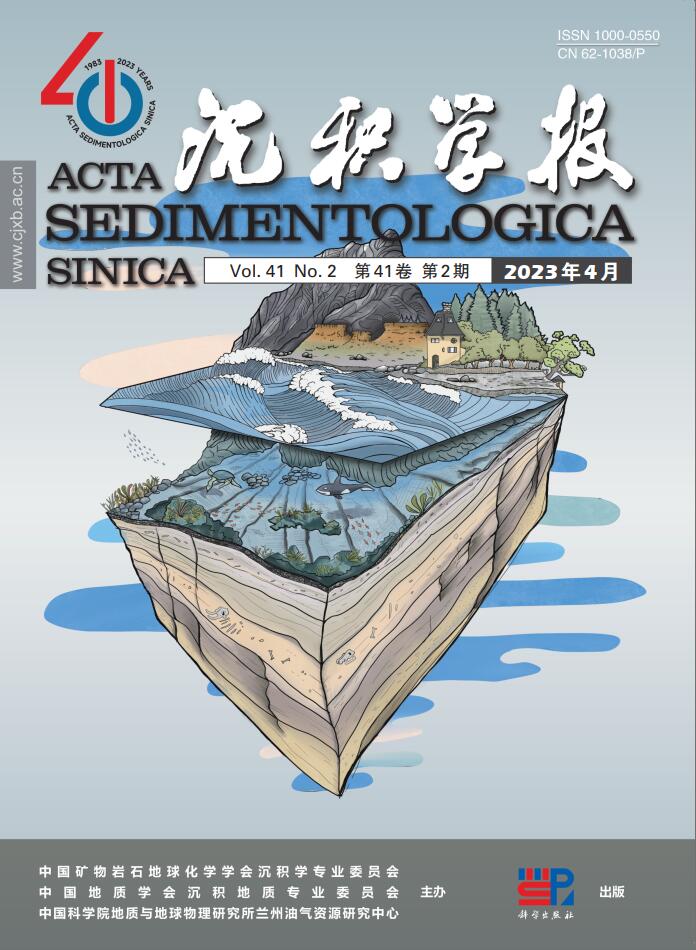HTML
-
研究我国西北地区中生代构造和环境演变过程,对认识我国现今环境格局形成和未来演变趋势具有重要意义。现有的研究表明,我国西北地区气候环境格局在三叠纪—始新世总体干热,渐新世以来趋于冷干,并经历了三叠纪—中侏罗世湿热、晚侏罗世—始新世干热和渐新世—第四纪干冷三个演变阶段[1]。目前对于渐新世以来的气候环境变化已经取得了比较详细的认识[2⁃10],对白垩纪气候变化也积累了比较多的资料[11⁃14]。但对晚三叠世—侏罗纪这一时段的气候演化研究还比较薄弱。侏罗纪是我国西北地区重要的成煤期,西起新疆,东至陕西,形成了许多重要的煤田。因此,研究侏罗纪气候环境演变,对认识我国现今气候环境格局演变过程,以及西北地区成煤环境及资源潜力具有重要意义。
鄂尔多斯盆地位于西北地区东部,煤炭资源占全国总量的34%,其中侏罗系延安组是重要的煤系地层[2],煤层具有自西向东、自北向南厚度逐渐减小的趋势[15⁃18]。近年来,在鄂尔多斯盆地西南缘甘肃平凉、庆阳等地相继发现了邵寨、新庄等大型煤矿田。从整个鄂尔多斯盆地来看,盆地西南缘延安组层序发育不完整,仅见下部一段至三段、且厚度变化较大[19⁃20]。前人对该区煤层形成环境进行了初步探讨[21⁃29],但对该区延安组总体的沉积环境、沉积过程及其与区域构造—气候环境演变的关系缺乏系统的研究,严重制约了对该区延安组成煤规律和资源潜力的认识。
本文选择甘肃陇东新庄井田4个含煤钻孔,通过单井测井沉积微相、连井沉积相分析等方法,结合区域构造—气候环境研究资料,系统分析了该区延安组的沉积环境及其时空演变特征,为认识该时期成煤规律及我国西北地区侏罗纪气候环境演变提供基础资料。
-
新庄井田位于甘肃省庆阳市宁县南部宁正矿区西南部,北部与宁中勘查区相连,南部以泾河为界与陕西省相隔,东部与核桃峪井田毗邻,西以兰州—青岛高速公路(西长风段)为界,面积206.28 km2。井田位于鄂尔多斯盆地陕北斜坡带的西南部,南邻渭北挠褶带,西连天环坳陷(图1)。鄂尔多斯盆地作为华北板块的一部分,自太古代基底形成以来经历了多次裂解—汇聚的构造旋回,并最终在中生代作为独立沉积盆地开始发展与演化。盆地南接秦岭造山带,北连阴山造山带,东至吕梁隆起,西邻六盘山冲断带。受燕山运动影响,盆地抬升剥蚀并形成如今东高西低的古地理格局[31⁃32]。

Figure 1. Tectonic map of southwest Ordos Basin (a, modified from reference [30]), location of the Xinzhuang well field (b) and its structural geology map (c)
新庄井田地层属华北地层区鄂尔多斯分区焦坪—华亭小区[33⁃34],自下而上发育上三叠统延长群、下侏罗统富县组、中侏罗统延安组、直罗组和安定组以及下白垩统志丹群、第四系,其中延安组是区域内的主要含煤地层。矿田内地层多被第四系覆盖,构造较为简单,自西向东发育5个NE—NEE向展布的背斜和向斜构造(图1c)。
-
根据钻孔揭露,井田内延安组厚38~64 m,平均厚48 m,与下部富县组、上部直罗组呈平行不整合接触。经与区域地层对比,区内延安组仅发育下部第一、二段,分别产出煤5层和煤8层(表1)。
第一段(J2y1):主要含煤段,含有煤8层。底部与富县组呈平行不整合接触,顶部以灰黑色薄层泥岩与延安组二段分界,平均厚15.40 m。自下而上由深灰色薄层泥岩或粉砂质泥岩、黑色厚层煤岩(煤8层)夹薄层炭质泥岩以及深灰色—灰黑色薄层泥岩组成。煤8层位于中上部,平均厚8.5 m,含煤性好,其底部普遍为含炭屑及植物化石的深灰色粉砂质泥岩或泥岩。
第二段(J2y2):该段顶部与直罗组呈平行不整合接触,与下伏延安组一段整合接触,厚度为1.09~62.34 m,平均33.51 m。下部由灰白色厚层中—粗粒含砾砂岩、灰白色中厚层中—细粒砂岩、灰色或灰黑色粉砂岩和泥岩组成向上变细的正粒序沉积,上部由灰—灰白色中层细砂岩和粉砂岩组成,夹深灰色薄层泥岩和黑色薄层煤岩(煤5层,分为5-1层和5-2层),煤层厚度平均为1.2 m,是井田次要含煤段。
-
王双明[35]和杜芳鹏[20]基于矿区勘查资料,以岩石地层为主要依据,根据其发育位置、煤层厚度、煤层物性特征等,将鄂尔多斯盆地延安组煤层时空分布进行了对比(表1)。张之辉[36]获得了东胜煤田延安组底部煤层中火山灰夹层的锆石U-Pb年代学结果,其中煤6-2s和6-2z煤层中火山灰的LA-ICP-MS年龄分别为173.3±2.4 Ma、173.7±1.6 Ma,煤6-2s、6-2z和6-1的CA-ID-TIMS年龄分别173.558±0.044 Ma、173.727±0.085 Ma和173.328±0.059 Ma,指示延安组沉积时间为中侏罗世阿林期。这些都为区域煤层年代对比提供了基础。
本文研究的新庄井田8号和5-1号煤层,与宁正矿区的煤层层序一致,分别对应东胜煤田6-2z(表1中VI-2)和5-1煤层(表1中V-1)。因而,新庄井田8号煤层形成的年代接近东胜煤田6-2z层的年代,约为173.7 Ma。区域上,延安组一段顶部多为煤层,该煤层顶部是延安组一段和二段的分界(表1),如张之辉[36]研究的东胜煤田6-2s(表1中的VI-1)号煤层,其中的火山夹层的锆石年代为173.558±0.044 Ma(CA-ID-TIMS),可以用来指示延安组一段和二段的界线年龄[36]。新庄煤田内部,延安组一段顶部没有煤层,不能直接利用东胜煤田的年龄结果推测延安组一段的顶部年龄。但可以利用张之辉[36]采用的旋回地层学405 kyr的长偏心率周期计算方法,获得新庄煤田5号煤层的顶界年龄约为172.78 Ma、延安组二段顶部年龄约为172.77 Ma。对于延安组的底界年龄,由于井田内延安组底部与下伏富县组呈不整合接触,因此无法确定延安组的底界年龄。这一推算结果还有待于进一步验证,但大致给出了新庄井田延安组一段和二段地层沉积及煤层发育的时间,可为盆地尺度上进行气候环境演变对比研究提供时间框架。
2.1. 延安组地层沉积与煤层特征
2.2. 地层年代框架
-
通过岩心观察、沉积构造识别和测井资料分析,新庄井田内延安组总体为缺少水体交流的较低能的三角洲平原环境,进一步可划分为沼泽、分流河道、河道间和天然堤四个微相(图2)。
沼泽微相主要出现在延安组一段中部和延安组二段上部。岩石类型以黑色煤岩为主,夹灰黑色炭质泥岩(图3a,b),煤岩具沥青质光泽。在煤岩和泥岩中常见植物化石碎片和黄铁矿结核,反映水体能量低的还原环境;自然伽马值极低,呈微齿化箱形(图4c);电阻率值极高,呈锯齿状。
-
分流河道多出现在延安组二段下部,由灰白色含砾粗砂岩、中砂岩和细砂岩组成向上变细的沉积序列(图3e,f),具有典型的河流二元结构。通常序列底部可见冲刷面(图3h),底部粗砂岩中常见次棱角状的石英砾,分选中等,砂岩常发育砂纹交错层理(图3c),呈块状构造,常见植物碎片化石,反映较强的水流作用;自然伽马值相对较低,电阻率值相对较高,自然伽马曲线表现为中低幅的微齿化箱型(图4a)和钟型(图4b),曲线顶底部通常为突变接触。
-
河道间微相多出现在延安组一段底部和顶部以及延安组二段上部,下部通常与分流河道微相过渡,上部通常与沼泽微相过渡。岩石类型以灰色—深灰色粉砂岩和泥岩,二者常互层产出。水平层理发育(图3d),局部见微波状层理,偶见黄铁矿结核,反映水动力较弱的还原环境;自然伽马值低、电阻率值高,自然伽马曲线表现为大幅度的指形(图4c),顶底一般呈渐变式接触。
-
天然堤微相主要出现在延安组二段中部和上部,主要由灰色粉砂岩、粉砂质泥岩或泥岩组成韵律互层,厚度较薄,一般为1~2 m,偶见黄铁矿结核和炭屑,发育炭质纹层(图3c),反映水动力比较弱的弱还原环境;自然伽马曲线表现为下部和上部相对较低、中部相对升高的向内开口的指形(图4c),底部通常呈突变式接触,电阻率值通常较低,反映较为动荡的水体环境。
根据前述钻井沉积微相类型及其组合,延安组沉积环境总体以三角洲平原为主。其中延安组一段以安静低能的河道间和沼泽环境为主。延安组二段下部以分流河道—天然堤的河流沉积序列为主,反映较强水动力条件下的氧化环境;上部以河道间—沼泽沉积序列为主,反映相对还原的低能环境。因此,新庄井田内延安组自下而上总体反映了水体由深变浅再变深,水动力由弱变强再减弱的过程。
-
为了深入理解井田延安组的沉积环境演变,在上述工作的基础上,在井田内东西向和南北向各选取了5个钻孔进行连井分析。井田内沉积中心位于政平镇西南N401井一带(图5a、图6)。受地势起伏和沉积环境影响,延安组在不同位置的厚度存在差异,东西方向存在两个沉积中心(东部地层厚),南北方向上南部地层沉积逐渐增厚,而且一段和二段在不同位置变化也不相同(图5)。
-
东西向连井分析显示(图5a),延安组一段均以河道间—沼泽相的低能沉积为主,沉积厚度变化较大,中间薄、两边厚,显示东西方向有两个沉积中心。西部沉积中心位于钻井N1101井(厚22.1 m),向东在N901井处地层变薄(厚约7 m),继续向东在钻井N601井、N401井一带形成另一个沉积中心,而井田边部钻井N101井处受地势影响未见沉积。这种横向变化,说明延安组一段沉积时具有中间高、两端低、东部边缘隆起的地貌格局,地层厚度变化可能是沉积物可容空间的变化导致的。煤8层在横向上厚度变化较小,平均为6.3 m,表明煤层沉积时东西向整体地势落差小。煤层沉积后,受构造抬升作用影响,靠近钻井N901#一带抬升区两侧,地势相对凹陷,沉积了较厚的延安组一段上部地层,厚约10~15 m(图5a)。
延安组二段下部以分流河道—天然堤的河流沉积体系为主,发育规模较大的分流河道砂体和天然堤砂体,在钻井N401井处厚度最大,向两边逐渐减小或尖灭,在钻井N901井处地层整体抬升被剥蚀,表明延安组二段早期沉积时研究区受燕山运动影响,中部发生隆起,河流进积作用加强,水动力增强;延安组二段上部主要发育河道间—沼泽沉积,原先的河道砂体上大多被泥岩或煤层覆盖,在钻井N401井处厚度最大,向两侧减薄。煤5层受局部高地抬升的影响,在横向分布上变化较大,厚度薄,在横向上变化不大,表明延安组二段晚期湖平面再次下降,但规模较小,在局部形成了薄煤层,沉积中心仍然位于N401井处。
-
南北向连井分析显示(图5b),延安组一段厚度具有自北向南逐渐增大的现象,煤层沉积总体与延安组一段沉积特征类似,表明该时期具有南低北高的地貌格局,自北向南水体能量逐渐降低;延安组二段早期北部抬升被剥蚀,南部发育较大厚度的河流沉积,河道砂体在203井和205井处发育较好,钻井204井砂体相对较薄,表明其可能位于两条分流河道之间,水动力比较动荡,发育多个天然堤—分流河道或河道间—分流河道的沉积,整体的沉积中心位于205井处;延安组二段晚期整体发育天然堤和河道间沉积,仅在局部发育薄煤层,且自北向南沉积厚度逐渐增大,沉积物粒度逐渐变小,表明该时期水动力条件减弱,南部钻井205井处仍然是整体的沉积中心。
3.1. 沉积微相特征
3.1.1. 分流河道微相
3.1.2. 河道间微相
3.1.3. 天然堤微相
3.2. 井田沉积环境演化
3.2.1. 东西向沉积环境变化
3.2.2. 南北向沉积环境变化
-
通过单井沉积微相和连井沉积相分析,结合区域测年资料[36],将新庄井田延安组沉积时的演化过程划分为四个阶段(图6),分别为延安组一段早期、延安组一段晚期、延安组二段早期和延安组二段晚期。
延安组一段早期发育大规模巨厚煤层,沉积环境以沼泽为主,指示气候温暖湿润;沉积厚度西南部最大,向北厚度逐渐减小,总体地势南低北高;延安组一段晚期研究区发生抬升,西北部已经开始遭受剥蚀,沉积环境以河道间为主,水体深度变深,西部和中部沉积厚度最大,向南北方向厚度逐渐减小,总体地势中间低,南北高。延安组二段早期研究区西北部抬升范围进一步扩大,导致河流作用加强,水动力突然增强,沉积环境以分流河道和天然堤沉积为主,在研究区中部以河道砂体沉积为主,东南部以河道间沉积为主,河道间发育较大规模的天然堤砂体,沉积中心主要位于西南部的河道中。延安组二段晚期盆地构造相对稳定,水动力较之前减弱,河道沉积规模减小,主要分布在研究区中西部,河道两侧则发育小规模的河道间粉砂质和泥质沉积,而研究区东部主要发育相对低能的沼泽沉积。
-
为了探讨鄂尔多斯盆地延安组沉积早期(第一段、第二段)古地理演化特征,我们收集整理了盆地代表性剖面,编制了盆地南北部延安组早期地层沉积变化图(图7),并结合全球气候环境变化及鄂尔多斯早侏罗世研究资料来展开讨论。

Figure 7. Sedimentary facies distribution map from the 1st to 2nd member of the Yan’an Formation in the Ordos Basin (data from references [20,23⁃24,37⁃45])
三叠纪末印支运动后,鄂尔多斯盆地整体抬升并形成了沟谷纵横、隆洼相间的古地貌格局[18]。植物大化石和孢粉资料显示早侏罗世早—中期(赫塘期至普林斯巴期)气候温暖潮湿、气温相对较高且具有明显的季节性变化特征[46]。盆地周边强烈的构造运动导致风化速率增强、物源供给充足,在盆地东北部神木一带、盆地西南缘沉积了富县组下部冲积扇和河流相沉积,岩性基本以含砾砂岩、砂岩和泥岩的互层为主,在下部夹有少量的页岩和煤层[18]。早侏罗世晚期(托阿尔期)全球大洋出现缺氧事件,海水温度明显升高[47-48]。鄂尔多斯盆地煤层沉积中断,孢粉和植物化石的类型及数量明显下降,出现大量喜热或耐干旱植物[46,49-50],浅水环境中出现大量的红层沉积,深水湖泊中发育暗色泥岩和页岩[51-53],指示当时气候炎热干旱。盆地中部继早—中期河流沉积之后,形成了规模较大的富县组上部冲积平原沉积[18,54];在盆地北部神木—榆林一带出现小规模的湖泊沉积[55],岩性大多以杂色砂岩和泥岩互层为主(图7,剖面⑪);在盆地南部则为河流相沉积(图7,剖面⑤⑥)。
全球尺度上,中侏罗世早期气候温暖湿润[46,50-52]。延安组沉积物中相对较高的化学风化指数CIA和CIW[36,56]以及温暖湿润的气候条件,表明此时物源区以化学风化为主,物理侵蚀较弱;稀土元素分析显示盆地内沉积物物源比较稳定[57],表明盆地周边构造相对稳定。同时,旋回地层学研究显示煤层往往发育于季节性差异低、气候变化稳定的405 kyr长偏心率周期的低值;相反,煤层上下沉积往往对应于季节性差异较强的长偏心率高值段[36]。这些背景研究结果为开展延安期气候和古地理微细变化奠定了基础。
如图7所示,在经历了早侏罗世的河流充填作用后,中侏罗世阿林期延安组开始了沉积。根据前述划分的阶段,阶段Ⅰ,盆地地势趋于平缓,气候温暖湿润,季节性差异低,稳定的气候条件增加了植被覆盖率,同时降低了物理侵蚀的效率,减小了陆源碎屑的输入,此时湖平面处于长期稳定的低水位状态,盆地内以较大规模的三角洲平原和沼泽沉积为主,为泥炭的形成和堆积提供了稳定的气候条件和可容空间(图8a),因此在新庄井田形成了巨厚的煤8层。此阶段,盆地西南缘炭山一带以湖泊沉积为主(图7,剖面①),向东至华亭—环县一带过渡为辫状河沉积(图7,剖面②③)凤翔一带过渡为曲流河相(图7,剖面④),正宁—彬县一带为三角洲平原相(图7,剖面⑤⑥),沉积粒度自西向东逐渐变细,表明此时隆起区距离华亭—环县一带较近。盆地北部大部分地区以河流相沉积为主(图7,剖面⑦⑨⑩⑪⑫),在灵武东侧至靖边一带可能形成了规模较大的冲积平原(图7,剖面⑧),表明灵武东侧—靖边一带是当时河流汇聚的中心。

Figure 8. Control of coal seam development using seasonal variation controlled by orbit parameters (modified from reference [36])
之后受燕山运动Ⅰ幕影响,阶段II盆地发生局部抬升作用,这一抬升作用可能与鄂尔多斯盆地周缘174~170 Ma期间的构造抬升事件[58-61]有关,与本次研究区延安组一段上部的剥蚀事件一致。此时季节性差异较强,逐渐向相对干燥的气候转变,植被逐渐稀疏,在季节性降雨增强的背景下,导致河流流量增强,周源碎屑物质更容易被搬运,在一定程度上阻碍了煤层的生长发育,盆地内沼泽沉积中断,被砂岩、粉砂岩为主的河道间沉积取代(图8b)。在盆地南部,西缘炭山一带沉积环境由湖相转变为河流相,岩性由泥岩转变为厚层中粒砂岩,沉积物粒度突然增大(图7,剖面①);在炭山以东,岩性则由煤岩转变为泥岩,沉积水体整体变浅(图7,剖面②③④⑤⑥),并在局部地段发生地层的抬升剥蚀。这些都说明盆地南部构造活动相对较强。而在盆地北部,仍以河流相(图7,剖面⑦⑪⑫)和冲积平原(图7)沉积为主,但沉积物粒度明显变细,由粗—中粒砂岩为主的河道沉积转变为以粉砂岩和泥岩为主的漫滩沉积;其中榆林和东胜一带出现三角洲平原沉积(图7,剖面⑩⑫);表明北部地势较为平坦,基本未受构造活动影响。同时,盆地中部延安—靖边一带出现了湖泊沉积(图7,剖面⑨),表明这一时期盆地中部下陷明显。
阶段III期间盆地周围进一步抬升,季节性差异进一步增强并逐渐达到最大值,气候相对干燥,植被发育进一步受阻,导致河流作用以及碎屑供给持续增强,三角洲平原的分流河道砂体进一步扩大(图8c),在延安组二段底部普遍发育一套标志性的巨厚砂岩层。盆地中心继续下陷,继承了阶段II湖泊沉积。盆地南部延安组二段下部沉积环境变化明显,河流相沉积仅在炭山和凤翔一带发育(图7,剖面①④),而在环县—华亭一带和宁正—长武一带则发育湖泊(图7,剖面②)和三角洲沉积(图7,剖面③⑤⑥),表明此阶段盆地西南缘以河谷地貌为主,而西南部整体地势已逐渐平原化。盆地北部延安—靖边一带湖泊规模进一步扩大(图7,剖面⑨),神木—东胜一带开始出现湖泊沉积(图7,剖面⑪⑫),在榆林—灵武一带则发育大范围的三角洲平原沉积(图7,剖面⑦⑧⑩);而且在三角洲平原和湖滨沼泽地区发育较薄的煤层。这些都表明北部受构造影响小,地势已整体平原化。
阶段IV季节性差异减小,气候逐渐向温暖湿润转变,降雨量减小使河流作用趋于稳定(图8d),碎屑物质输入逐渐减少,以湖泊三角洲和湖泊沉积为主,在三角洲平原上发育小规模的煤层,在新庄井田为煤5层(图7,剖面⑥)。盆地南部与阶段III相比,在东南部相对沉降形成湖泊[18],环县—华亭一带湖泊范围扩大(图7,剖面②③),在西缘炭山一带则以三角洲平原沉积为主(图7,剖面①)。表明盆地西南部发生了明显的沉降。盆地北部的神木—东胜一带则由湖泊沉积转变为了三角洲沉积(图7,剖面⑪⑫),岩性由泥岩转变为中粒砂岩,河流进积作用增强,带来了较多的碎屑物质。与此同时,盆地中部延安—靖边—榆林一带湖泊范围进一步扩大(图7,剖面⑨⑩)。这些表明盆地北部地势依然平坦,湖泊在向北扩张。
4.1. 新庄井田延安组早期古地理演化
4.2. 中侏罗世早期鄂尔多斯盆地古地理演化
-
(1) 新庄井田延安组整体为三角洲平原沉积,进一步划分为河道间、沼泽、天然堤和分流河道四种微相类型,煤层主要形成于河道间沼泽环境。延安组一段下部、上部分别为沼泽和河道间环境,二段下部和上部分别为分流河道—天然堤、河道间—沼泽环境,延安组一段沉积水体较浅、水动力弱,二段下部水体变深、水动力增强,上部水体变浅、水动力变弱。
(2) 连井沉积相分析显示新庄井田煤层的发育受控于中侏罗世早期温暖湿润的气候,延安组一段与二段界线处局部抬升作用导致煤层分布不连续。
(3) 中侏罗世早期鄂尔多斯盆地整体以温暖湿润的气候为主,古地理环境经历了气候温暖湿润—沼泽、相对干旱—河道间、干旱—分流河道、温暖湿润—河道间和沼泽四个演化阶段。












 DownLoad:
DownLoad:






